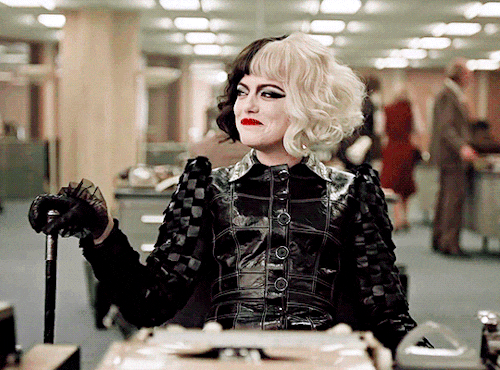
It’s hard to pinpoint when exactly Disney’s villains became more interesting than their princesses, but somewhere along the way the company’s marketing geniuses figured out that ominous figures driven by revenge could be just as aspirational —at least in a figuratively fashionable sense— as beautiful ones driven by love. With some contemporary exceptions, the goal for female characters in the Disney universe has always been about snaring Prince Charming (or Prince whoever) and living happily ever. Its animal driven animated films are another story, but even those tend to idealize innocence and oversimplify evil, creating a black and white narrative that never went too deep into motivations and never had to considering the target audiences were children.
Which makes Cruella, the latest live action take on a classic character angled at the dark comedy/goth crowd, so refreshing. The backstory here is bodacious but it has actual depth and a twist you might not see coming, with complex characters that you’ll enjoy inspite of their flaws. There’s no romance here whatsoever, and yet, there are moments when Cruella (Emma Stone, in one of her most charismatic portrayals ever) pulls at your heart strings. It’s to the actress’s credit that she does so as the sinister two-tone tressed Cruella De Vil, but equally so as her meek and awkward alter-ego Estella.
In 101 Dalmations (the cartoon and the live action film from 1996 starring Glenn Close) we didn’t know a lot about Cruella other than the fact that she wanted to kill puppies to make a fabulous fur coat. I, Tonya director Craig Gillespie and writers by Dana Fox and Tony McNamara, clearly strove to humanize what’s essentially been one of the craziest Disney villains in history and they succeed. But even if they hadn’t, there’s enough eye candy styling and raucous rivalry on screen to delight regardless.
To this end, the Cruella soundtrack is pretty incredible too; we’re talking The Stooges, The Stones, The Doors and two Ike & Tina Turner covers (“Whole Lotta Love” and “Come Together”), all of which informs both the narrative and the movie’s splashy montages in a way that’s on the nose and music video-like, but maintains a wicked edge and sensibility, especially for a Disney vehicle. This duality is in fact, the essence of the film, which aims to give its anti-heroine a relatable rationale for her provocations while still keeping her de-vil-ish. It succeeds in fiendish fashion.



